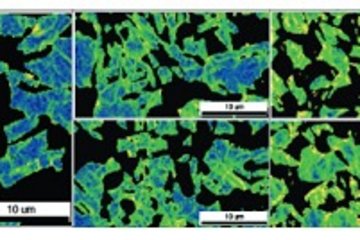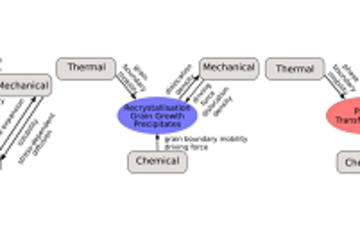All genres
1321.
Talk
Micromechanics using spectral method: Modelling of interface decohesion in polycrystalline microstructures. PETSc User Meeting, Vienna, Austria (2016)
1322.
Talk
An ab-initio prediction of the off-stoichiometry of Fe–Mn–Al–C κ carbides. CALPHAD XLV, Awaji Island, Hyogo, Japan (2016)
1323.
Talk
From grains to atoms: ping-pong between experiment and simulation for understanding microstructure mechanisms. Res Metallica Symposium, Department of Materials Engineering, KU Leuven, Leuven, The Netherlands (2016)
1324.
Talk
Integrated experimental and simulation analysis of dual phase steels. Workshop on Possibilities and Limitations of Quantitative Materials Modeling and Characterization 2016, Bernkastel, Germany (2016)
1325.
Talk
Segregation engineering in medium manganese steels. Workshop Integrated Computational Grain Boundary Engineering: The role of segregation, Graz, Austria (2016)
1326.
Talk
Materials Engineering through the Ages: from the Battle of Kadesh to Atomic Scale Materials Design. Elite Network of Bavaria (ENB) Forum in Erlangen: Focus on Materials Engineering, Erlangen, Germany (2016)
1327.
Talk
Structure and Properties of Grain Boundaries in CdTe Solar Cells. E-MRS 2016 SPRING MEETING, Lille, France (2016)
1328.
Talk
Correlation between the 5-parametric GBCD and the corrosion resistance of a 304 stainless steel by 3D-EBSD. RMS-EBSD Meeting 2016, Manchester, UK (2016)
1329.
Talk
Origin of the off-stoichiometry of Fe–Mn–Al–C κ carbides: An ab-initio explanation of atom probe tomography data. DPG 2016, Regensburg, Germany (2016)
1330.
Talk
Unexpected Stress Induced Martensite Formation in Ultra-strong Pearlitic Steel. 2016 TMS Annual Meeting & Exhibition, Symposium: Advanced Characterization Techniques for Quantifying and Modeling Deformation
, Nashville, TN, USA (2016)
1331.
Talk
Micro-scale fracture behavior of Co based metallic glass thin films. 2016 TMS Annual Meeting and Exhibition Symposium: In Operando Nano- and Micro-mechanical Characterization of Materials with Special Emphasis on In Situ Techniques, Nashville, TN, USA (2016)
1332.
Talk
Computational analysis of irregular rolling deformation in Nickel Aluminide single crystals. Thermec 2016, Graz, Austria (2016)
1333.
Talk
Measurement of grain boundary chemistry and crystallography by atom probe tomography and correlated electron microscopy. Thermec 2016, Graz, Austria (2016)
1334.
Talk
Shear Transformation in a Non-Equiatomic CoCrFeMnNi High-Entropy Alloy. 2016 MRS Fall Meeting, Boston, MA, USA (2016)
1335.
Talk
Designing and understanding novel alloys towards superior properties. 2016 European Workshop on Materials Design, Grenoble, France (2016)
1336.
Talk
Metastable High-Entropy Dual-Phase Alloys with Joint Increase in Strength and Ductility. 2016 MRS Fall Meeting, Boston, MA, USA (2016)
1337.
Talk
Interstitial Compositionally Complex Alloys with Transformation and Twinning Induced Plasticity. 2016 MRS Fall Meeting, Boston, MA, USA (2016)
1338.
Talk
Interfacial dislocation motion in single-crystal superalloys: dislocation interactions, vacancy supersaturation, and directional coarsening. Plasticity '16: The 22nd International Symposium on Plasticity & Its Cur
rent Applications
, Keauhou Bay, HI, USA (2016)
1339.
Talk
Austenite formation along dislocations in medium manganese steels. Thermec 2016, Intl. Conf. on Processing & Manufacturing of Advanced Materials, Graz, Austria (2016)
1340.
Talk
Thermodynamics and Mechanical Properties of Non-Equiatomic CoCrFeMnNi Alloys. 2016 MRS Fall Meeting, Boston, MA, USA (2016)











